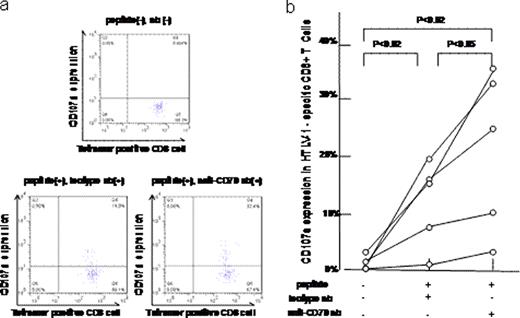Abstract
Abstract 1730
Human T-lymphotropic virus type-1(HTLV-1) is the causative agent of adult T cell leukemia/lymphoma (ATL). HTLV-1 infected T cell growth or leukemogenesis in ATL is controlled by various host immune surveillance systems. Among them, CD70 on HTLV-1 infected T cells coupled with CD27 on virus specific cytotoxic T cells has been suggested to play an important role in ATL leukemogenesis. The CD70 molecule is the only known ligand for CD27, a member of the tumor necrosis factor (TNF) receptor superfamily 7. This negative immunoregulatory pathway downregulates cytotoxic T lymphocyte activity against CD70-expressing virus infected cells. In the present study, we examined CD70 expression on primary lymphocytes of HTLV-1 carriers and ATL patients, its relationship with HTLV-1 Tax protein expression, and the effect on CTL induction. CD70 expression was higher on peripheral blood mononuclear cells (PBMCs) of HTLV-1 infected carriers compared with healthy donors (p = 0.021, n = 21, Mann-Whitney U test), and higher in ATL patients compared to carriers (p = 0.045, n = 38, Mann-Whitney U test). CD70 expression may be observed in CD4 T cells, as well as B cells, but not in CD8 T cells or monocytes. CD70 expression in CD4 T cells is related to HTLV-1 infection, because of increased detection of HTLV-1 Tax protein during over night culture of CD70-expressing cells. Experiments using an ATL cell line, in which Tax expression is inducible by doxycycline stimulation, demonstrated enhanced CD70 expression when Tax protein was induced in HTLV-1 infected cells. Anti-CD70 antibody enhanced CD107a mobilization, a marker of recent cytotoxic degranulation, in HTLV-1 Tax specific CTLs in PBMCs from asymptomatic carriers in vitro, suggesting that the CD70/CD27 pathway plays an important role in the immune response to HTLV-1 infection in carriers, as well as ATL patients.
Upregulation of CD107a expression by anti-CD70 antibody on HTLV-1 Tax tetramer specific cytotoxic T lymphocytes (CTLs). (a) Representative flow cytometric dot plots showing increased CD107a expression in HTLV-1 Tax tetramer specific CTLs treated with anti-CD70 blocking antibody compared with isotype antibody. Freshly isolated peripheral blood mononuclear cells were incubated with or without 0.02 μM HTLV-1 Tax peptide in the presence of anti-CD70 blocking antibody or isotype control (10 μg/ml) for 4 hours. Analysis was performed on a FACScan flow cytometer (BD Bioscience, San Jose, CA, USA) and with FlowJo software (Tree Star, Ashland, OR, USA). Lymphocytes were gated on forward and side light scatter properties, followed by gating on CD8+ tetramer+ CTLs. (b) Summary of CD107a expression in HTLV-1 Tax tetramer specific CTLs after incubation with anti-CD70 blocking or isotype control antibody. P < 0.05, Wilcoxon matched-pairs test.
Upregulation of CD107a expression by anti-CD70 antibody on HTLV-1 Tax tetramer specific cytotoxic T lymphocytes (CTLs). (a) Representative flow cytometric dot plots showing increased CD107a expression in HTLV-1 Tax tetramer specific CTLs treated with anti-CD70 blocking antibody compared with isotype antibody. Freshly isolated peripheral blood mononuclear cells were incubated with or without 0.02 μM HTLV-1 Tax peptide in the presence of anti-CD70 blocking antibody or isotype control (10 μg/ml) for 4 hours. Analysis was performed on a FACScan flow cytometer (BD Bioscience, San Jose, CA, USA) and with FlowJo software (Tree Star, Ashland, OR, USA). Lymphocytes were gated on forward and side light scatter properties, followed by gating on CD8+ tetramer+ CTLs. (b) Summary of CD107a expression in HTLV-1 Tax tetramer specific CTLs after incubation with anti-CD70 blocking or isotype control antibody. P < 0.05, Wilcoxon matched-pairs test.
No relevant conflicts of interest to declare.
Author notes
Asterisk with author names denotes non-ASH members.


This feature is available to Subscribers Only
Sign In or Create an Account Close Modal